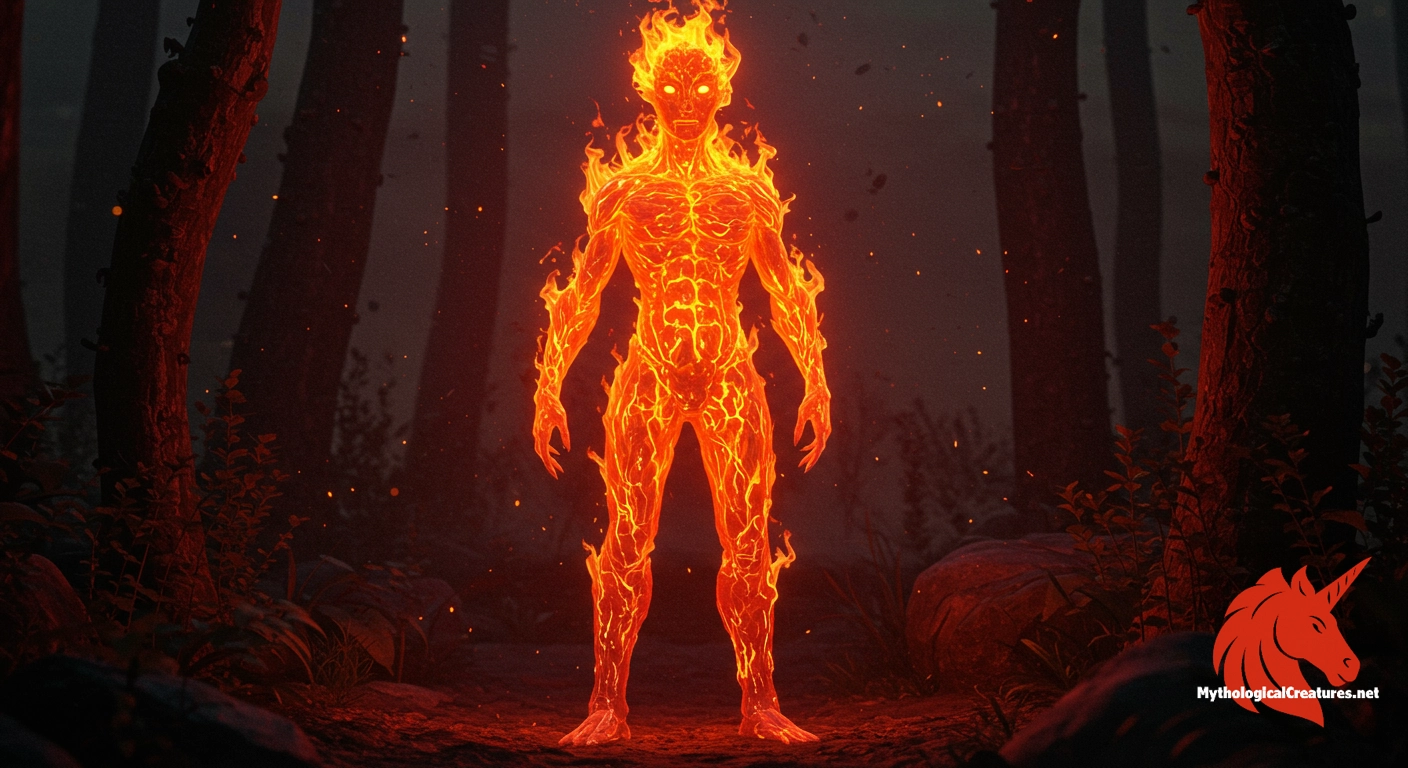Od iyesi: Od iyesi is the revered Turkic and Mongolic spirit of fire, safeguarding the flame in both domestic and natural realms.

Od iyesi
Od iyesi - Od iyesi is revered as the divine protector of fire, ensuring its purity and vital role in both domestic and natural settings.
Origins & First Encounters
The entity known as Od iyesi occupies an essential niche in the mythological landscapes of Turkic and Mongolic cultures, representing the divine essence of fire. Its name, derived from the Turkic word for fire, 'od', and the term 'iye', meaning master or spirit, encapsulates the intimate relationship ancient peoples had with this elemental force. Emerging from a rich tradition of animistic belief, Od iyesi is both protector and personification of fire, safeguarding it as a sacred resource. The spirit’s origins can be traced back to pre-Islamic shamanistic rituals where fire was revered for its transformative and purifying qualities. Early attestations in oral traditions and epic narratives serve as a testament to the deity’s long-standing significance in communal and domestic life. Over time, Od iyesi came to epitomise not only the physical warmth of fire but also its symbolic roles in regeneration, destruction, and illumination. The myth has been passed down through generations via poetic storytelling and ritual practices, preserving its mystique and relevance. This multifaceted character, blending physical power with spiritual guardianship, continues to inspire cultural memory and artistic representation throughout the regions it touches.
Source Texts & Tale Variants
Ancient manuscripts and folklore traditions, though often fragmentary, provide valuable insights into the various interpretations of Od iyesi. Oral histories passed down in the steppe regions recount legends where the spirit was invoked during fire ceremonies and seasonal celebrations. Various Turkic epic cycles, sometimes recounted in the form of poetic narratives, hint at the protective role of the guardian of flames and emphasise its connection to the natural world. In Mongolic and Siberian shamanistic texts, the portrayal of fire as a living entity further reinforces the spirit’s dual nature of nurture and danger. Ritualistic accounts found in regional lore often depict intricate ceremonies designed to honour this fire deity, ensuring that the sacred flame remained undimmed. Manuscripts written in archaic Turkic script and later transcriptions in Mongolian further echo these motifs, although the texts vary in stylistic detail and interpretation. Folklorists have noted subtle differences in the tales from disparate regions, suggesting that the narrative of Od iyesi evolved according to local needs and spiritual lexicons. These multifarious sources together establish a broad spectrum of story variants, each uniquely reflecting the community’s reverence for the elemental force of fire.
Form & Powers
While Od iyesi is an inherently ethereal spirit, traditional depictions often imbue it with striking, luminous qualities that correspond to the nature of fire itself. Some descriptions portray the deity as a humanoid figure composed of swirling flames, with a form that is ever-changing and fluid like a dancing fire. In certain artistic renditions, the entity appears as a silhouette outlined in radiant embers, with eyes that sparkle like burning coals. The spirit’s body is sometimes depicted as a cascade of light and flickering sparks, symbolising both its nurturing warmth and its potential for destruction. Varying accounts suggest that its size and brilliance fluctuate, reflecting the unpredictable nature of fire across different contexts. There is a palpable sense of movement in these visions, as though the figure itself is in a constant state of burning transformation. Some traditions feature additional embellishments, such as trailing wisps of smoke or a halo of sparks, which enhance its mystical presence. Overall, the vivid physical imagery employed to portray Od iyesi not only highlights fire’s natural allure but also its role as a dynamic agent in the cosmos.
Regional Faces
Across the vast expanses of Eurasia, the portrayal of Od iyesi adapts subtly to accommodate the cultural and environmental nuances of each region. In Turkic tradition, the deity is often regarded as the benevolent guardian of the hearth and communal fire, playing a pivotal role in domestic rituals and family gatherings. Mongolic interpretations, on the other hand, frequently highlight the wild and unpredictable side of the spirit, echoing the untamed character of the steppes. In the Chuvash tradition, narratives of Od iyesi intertwine with local customs, where it is celebrated not only as a protective force but also as a symbol of continuity and prosperity. Sakha culture introduces shamanistic elements, viewing the spirit as a mediator between the earthly realm and the supernatural world. Variations in the narrative often reflect the differing environmental challenges and societal structures of each region, such as the reliance on communal fires to fend off harsh climates. Festivals and rituals dedicated to the fire spirit may incorporate regional symbols, costumes, and musical traditions, thus enriching the myth’s local flavour. Despite these differences, there exists a shared reverence for the potent, life-sustaining force of fire that binds the regional adaptations together in a cohesive cultural tapestry.
Cultural Parallels
The concept of a fire guardian is a recurring motif found in myriad world mythologies, inviting comparisons between Od iyesi and similar deities across cultures. In the Vedic traditions of India, the deity Agni similarly serves as the intermediary between the divine and the mortal realms, underscoring the sacred role of fire. Much like Od iyesi, Agni embodies the dual nature of fire—both a nurturer and a destroyer—imbuing rituals with an element of transformative power. In ancient Greek mythology, the hearth goddess Hestia symbolises domestic unity and the sanctity of fire, establishing a parallel in the importance of communal flames. While Western interpretations may focus on a stabilising, home-bound aspect of fire, the dynamic and sometimes ferocious qualities of Od iyesi resonate with narratives of elemental chaos and rebirth found in many indigenous cultures. Comparatively, fire spirits in Siberian shamanism exhibit a blend of grace and intensity reminiscent of the fluctuating morphology of Od iyesi. These cultural parallels illustrate a widespread, almost universal awe of the transformative and unpredictable nature of fire. Each myth, though shaped by its specific historical and environmental context, resonates with a shared human experience and a recognition of fire as both a vital resource and a mysterious, otherworldly force.
Legacy & Modern Evolution
Throughout history, the myth of Od iyesi has evolved in tandem with shifting cultural, environmental, and social landscapes. In pre-modern societies, its depiction was intimately linked with survival rituals, where fire was revered as a key ingredient for life and transformation. Over the centuries, as literary traditions began to document oral histories, the spirit of fire acquired symbolic roles that transcended mere physical phenomena. In modern interpretations, Od iyesi is often reimagined as a metaphor for both creativity and the inherent risks of uncontrolled passion or industrialisation. Contemporary artists and writers draw upon the imagery of this fiery deity to explore themes of renewal, destruction, and the interplay between nature and civilisation. Neo-pagan and revivalist movements have also embraced the figure, integrating it into modern ceremonies that celebrate the elemental balance of nature. The allegorical significance of Od iyesi continues to influence modern environmental discourse where fire is seen as both a natural force and a catalyst for change. Today, the enduring legacy of this ancient myth serves as a bridge between past and present, skillfully weaving together traditional beliefs with modern cultural expression.
Interesting Fact
Od iyesi not only represents the physical essence of fire but also symbolises the cyclical nature of destruction and renewal, highlighting fire's dual role in creation and purgation.
Quick Creature Info
Origin:
Associations:
Our Mythic Legendary Rating:

Also Sometimes Known As:
Habitat:
Supernatural Powers:
Physical Attributes:
Abilities:
Behavior:
Weaknesses:
Lore:
Related Creatures, Tales or Lore
- AAgni
- PPele
- IIfrit
References
Discover Another Mythical Legend You May Not Have Heard Of?
Uncover the mysteries of ancient folklore and expand your knowledge of legendary beings from cultures around the world.
Dare to Meet the Epimeliad....
Mythical Disclaimer: The images and data on this site are derived from various historical and literary sources, but we have found that many myths often have multiple versions and interpretations across references, sometimes contradictory. As a result, these creature depictions are artistic interpretations—imaginative blends of folklore, legend, and a dash of AI guesswork. Because creature descriptions vary widely, our illustrations and accompanying information represent our best effort to honor mythology while bridging creative gaps. Enjoy these interpretations—just remember, we've done our best to respect the stories and validate available data, but in the realm of mythology, details often shift, imagination leads the way, and nothing is ever set in stone!
Curated by the Mythological Creatures Team (rev. May 2025)
